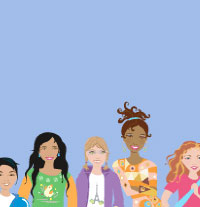Wednesday, February 2, 2005
Beacon Street Girls

Are girls aged 9 -13 too old for toys, and too young for boys? Do they need their own stuff? B*tween Productions, Inc thinks so, and launched this interesting Web site to complement their "Beacon Street Girls" books. The Beacon Street Girls are 4 fictional girls from Brookline, a suburb of Boston: Avery, Isabel, Charlotte and Mauve.
I'm so curious about how these characters were developed. Intended to be role models for young girls, they teach "socially responsible values in a delectable hot fudge sundae of fun and friendship." The Web site design is sugar sweet and upbeat in tone. All the characters have their own sections, with a "this week in my life" section. Avery's is a blog, of some sorts. In one post, she asks:
"Question of the week: Why do people call short people cute? It's really annoying. We don't like to be called cute. It makes us feel like windup toys!"
Well, I hate to say it, BUT... aren't these character "cute"? They are all slim, wonderfully dressed, some equipped with almost "adult" jewelry. Katani, at this young age, seems way too vain and writes in her "this week in my life" section that before she goes to bed, she'd like to "try new mud masque". Did her parents buy this stuff for her? Katani even has her own design line named K-girl (Wow. That's some pressure right there, if you're 12. Why don't YOU have your own design line?).
After some browsing around the website, these Pollyanna characters all began seeming like the same person to me. They all have the same smiles, eyes, noses, and faces (although they have different colorings). Sigh.
Actually, it was heart breaking. At the Web site's surface level, none of these characters seem to have any of the problems my peers and I experienced when we grew up. Has the world changed this much? Am I already out of touch..?
In my class room when I was 12, fat Anne wanted to be an opera singer. We all laughed, rolling our eyes. I was skinny and tall: they boys once locked me inside the bathroom when the school bell rang... I could escape through the keyhole, couldn't I? There was Celia, with the black, shiny hair and blue eyes, who grew perfect breasts before any of the rest of us. After Phys Ed classes she'd proudly flaunt them in front of the mirror in the girls wardrobe, shaking them from side to side so we'd have the opportunity to see precisely how big & bouncy they were. Wearing socks and toilet paper in our own (otherwise empty) bras, we publicly adored her and silently hated her. Then there was Lina, who claimed she was born a boy! Could girls be born boys?? We didn't think so. Appalled and disgusted, we kept her at a distance, except when she brought us goodies (which we inhaled and then ditched her). We were mean little bastards and proud of it.
Not exactly hot fudge sundae, or what? Do we need fudge and upbeat to teach young girls values?
I got curious about where these characters came from, and found an online interview with Addie Swartz, the CEO of B*tween Productions. Here is what she said:
We interviewed a healthy cross-section of girls from different socio-economic groups. We met them in after-school programs, at Boys and Girls Club centers, and at soccer games.They provided great ideas and input about what the characters should be like — even how they should look and dress. School emerged as a common theme among the girls we spoke with. From this field research we created composite characters.
So I have to wonder. Did these characters emerge from a blueprint of the average young American girl's fantasies? From the imaginations (or aspirations?) of their parents? Their teachers? Are they the real young American women to be?
READ TEKKA!
ABOUT THIS BLOG
Interesting idea?
Monthly Archives:
December 2004
November 2004
January 2005
March 2005
April 2005
Categories
- Anecdotes (35)
- Art (4)
- Design (4)
- Events (16)
- Fiction (4)
- Film/TV (1)
- Hypertext (5)
- Jobs (2)
- Media (36)
- Reading (9)
- Tinderbox Troll (4)
- Weblogs (4)
Tinderbox
This site is powered by Tinderbox.
Tinderbox is the tool for notes. Give it a try!
